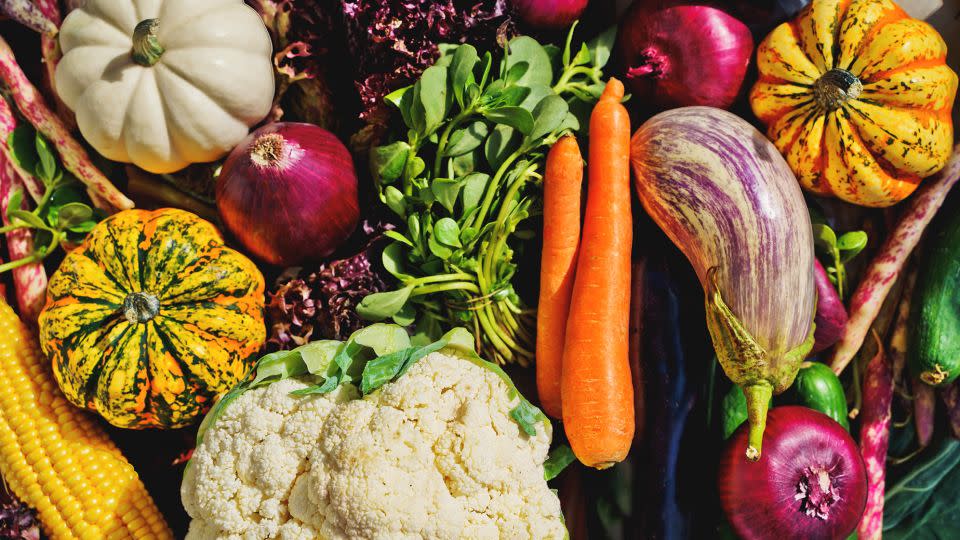There’s actually no such thing as vegetables. Here’s why you should eat them anyway
Get inspired by a weekly roundup on living well, made simple. Sign up for CNN’s Life, But Better newsletter for information and tools designed to improve your well-being.
The rumors are true: Vegetables aren’t real — that is, in botany, anyway.
While the term fruit is recognized botanically as anything that contains a seed or seeds, vegetable is actually a broad umbrella term for many types of edible plants.
You might think you know what carrots and beets are. Carrots, beets and other vegetables that grow in the ground are actually the true roots of plants. Lettuce and spinach are the leaves, while celery and asparagus are the stems, and greens such as broccoli, artichokes and cauliflowers are immature flowers, according to Steve Reiners, a professor of horticulture at Cornell University’s College of Agriculture and Life Sciences.
As for produce that grow from flowers, such as peppers and tomatoes, the hot-debated crops are botanically classified as fruits, Reiners added. Cucumbers, squash, eggplant and avocados are also classified as fruit due to their anatomy, according to the European Food Information Council.

What is a vegetable?
The term vegetable does not have a set definition when it comes to botany. However, in horticulture, the science of growing garden crops, a vegetable is defined as any herbaceous plant — a fleshy plant that completes its life cycle in a growing season — in which some portion “is eaten either cooked or raw, during the principal part of the meal, and not as like a snack or dessert,” Reiners said.
The legal definition of a vegetable versus a fruit — at least in the United States — was determined during a 19th century US Supreme Court case that concluded that the tomato is a vegetable.
While vegetables are really just the roots, stems and leaves of plants, experts don’t recommend eating just any roots, stems and leaves.
One example is rhubarb. The fleshy stalk is the edible part of the plant, but the leaves are poisonous, Reiners said. Stay safe by eating plants that grocery stores commonly call vegetables.
“We know (vegetables) are healthy. We know the vitamin content, we know the mineral content,” Reiners said. “We know how much fiber is in all of it.
“We also know that the vegetables that you either grow or you’re purchasing at a farmers market or grocery store are safe to eat,” he said.
Eat your vegetables
By understanding the various parts of vegetables and the nutrients they carry, people can eat well, according to Sherri Stastny, a registered dietitian and a professor in the department of health, nutrition and exercises sciences at North Dakota State University.
A head of broccoli is a great source of nutrients, but the stem of the green, which is more commonly thrown out, is also rich in fiber and nutrients, Stastny said. The regular consumption of flowery produce such as broccoli and cauliflower have been found to be associated with a decrease in the risk of cancer, she added.
“Heart disease is still the No. 1 killer in the United States, and we know that if you eat enough fruits and vegetables, you lower your risk for heart disease — and that goes along with obesity, diabetes and all these other chronic diseases,” Stastny said.
It is important to eat a variety of vegetables since each one will have varying beneficial nutrients, she added. Dark leafy greens such as spinach and kale are great sources of certain phytonutrients, natural nutrients from plants that are beneficial to human health, that help to maintain sharp eye vision, while carrots will help to strengthen night vision.
“If you think of the richest, darkest, most colorful vegetables, that’s where you’re going to find those (nutrients),” Stastny said, while potassium-rich vegetables and fruit, such as potatoes, pumpkin and squash, could help to lower and maintain blood pressure.
‘Start them young’
For parents looking to get young kids to eat their fruits and veggies, breaking down the anatomy of the plant, while describing the colors, taste and texture, could be a fun and educational way of introducing the nutrient-dense foods to the early explorers.
“Start them young,” Stastny said. “If you introduce children to vegetables at a younger age … they’re more likely to eat vegetables throughout their lifespan and therefore decrease the risk of chronic disease.”
For more CNN news and newsletters create an account at CNN.com


